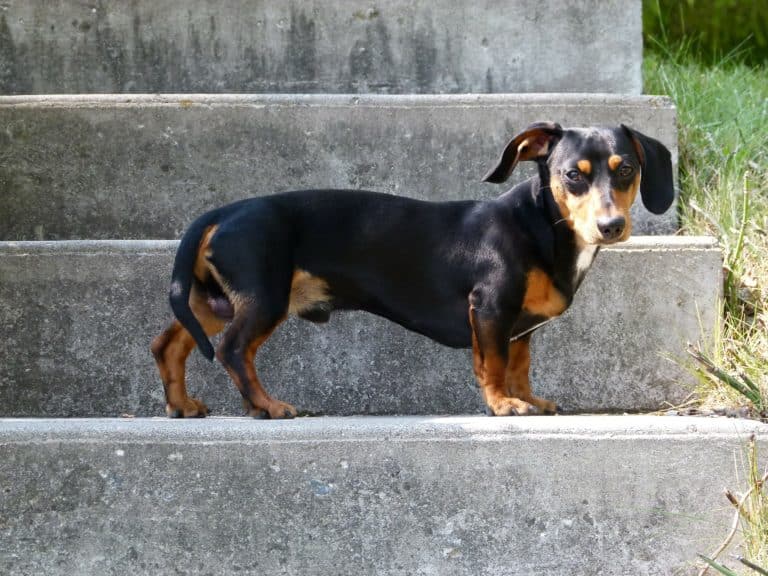Are Puppies Allowed to Climb Stairs?
- Anja Boecker
- Updated: 2023-11-15
This is a question that many puppy owners ask themselves. Many warn of joint damage from putting dogs under so much stress at such a young age. Others feel that climbing stairs is safe. This article will help you make the right decision.

A happy bark, a wagging tail, little paws scampering around the house - the arrival of a puppy brings life and joy to the home. But with joy comes many questions:
"Can puppies climb stairs?", "When is it safe for them to do so?" and "What if my dog is afraid of stairs? In this article, we'll get to the bottom of all these questions and give you practical instructions on how to teach your little friend to climb stairs safely.
Climbing Stairs With Puppies
Bringing a puppy into your home is an adventure full of joy, energy, and new challenges. Along this exciting journey, you will be faced with many questions, one of which comes up frequently: "Can puppies climb stairs?"
In the past, there was often uncertainty and concern about the potential risks of stair climbing for young dogs. Today, with the latest science, we are taking a fresh look at this issue and finding a balanced approach for your puppy's health and development.
Exercise plays a critical role in your puppy's development-not only promoting physical health, but also cognitive and emotional development.
Recent studies show that when approached and supervised correctly, stair climbing can be a valuable part of your puppy's daily life. It's a matter of striking a balance that accommodates your puppy's curiosity and natural urge to move around without neglecting his safety and health.
In this article, we will look at the latest research on puppy stair climbing. I'll give you practical tips on how to safely and gradually introduce your puppy to this everyday activity.
My goal is to help you build a solid foundation for the long-term well-being and health of your furry family member as you explore the world together.
The Importance of Exercise for Puppies

The importance of exercise for puppies is a multifaceted topic that encompasses both the physical and psychological development of young dogs. Here are some key points that highlight the importance of exercise for puppies:
Promoting Physical Health
Exercise is critical to the development of strong bones and muscles in puppies. Regular, age-appropriate activity will help their bodies grow strong and healthy. Exercise also promotes cardiovascular health and helps prevent obesity, which is especially important for breeds prone to joint problems.
Development of Coordination and Motor Skills
Through playful activities such as running, jumping, and climbing stairs, puppies learn to improve their body coordination and motor skills. These skills are critical to their overall dexterity and well-being.
Such activities also help puppies develop their spatial awareness and sense of balance, which are essential for daily interaction with their environment.
Cognitive Development and Learning Ability
Exercise and play are intimately linked to a puppy's cognitive development. By actively interacting with their environment, puppies learn new skills, develop problem-solving abilities, and improve their memory.
Activities that provide mental stimulation, such as learning commands or playing brain games, will develop the puppy's mental agility and attention.
Social Interaction and Behavioral Development
Exercise and play in interaction with people and other dogs are critical to the social development of puppies. They learn communication skills and establish social hierarchies. Such interactions also help puppies learn appropriate behaviors, including play, socialization, and bonding.
Emotional Well-Being and Stress Reduction
Regular exercise helps reduce stress and anxiety in puppies. Exercise allows puppies to channel their energy in a positive way and promotes an overall sense of well-being.
Play and physical activity can also help prevent or alleviate behavioral problems that often result from boredom or unused energy.
Remember:
Exercise for puppies is an essential part of their development. It not only promotes their physical health, but is also crucial for their cognitive, social and emotional development.
A balanced amount of exercise appropriate to the puppy's age, breed, and individual needs is the key to a healthy and happy life for your dog.
The latest findings in veterinary medicine and behavioral research show that appropriate exercise, including playing with littermates and climbing stairs, is extremely beneficial for puppy development. There are several important reasons for this statement
- The importance of playing with brothers and sisters: Playing with siblings allows puppies to practice social interaction and communication. They learn to interpret body language, respect boundaries, and navigate social structures.
Through play, puppies also learn to adjust their behavior. They develop an understanding of appropriate play behavior, which contributes to better social behavior. - Stair climbing transportation: Climbing stairs is an excellent exercise for strengthening muscles and improving coordination and balance. It promotes the puppy's physical fitness and agility.
Climbing stairs requires a certain amount of cognitive effort and therefore promotes brain development. Puppies have to estimate distances and coordinate their movements. - Get enough exercise: It is important that exercise is appropriate for the puppy's age, breed, and individual abilities. Too much or too intense exercise can be just as harmful as too little. A gradual introduction is recommended, especially for activities such as climbing stairs. This will allow the puppy to get used to the exercise slowly and minimize the risk of injury.
- Emotional and behavioral development: Both playing with siblings and climbing stairs help puppies develop confidence in their environment and their abilities. This can help reduce anxiety and insecurity.
- Prevention of behavioral problems: Sufficient and appropriate exercise can help prevent behavioral problems caused by boredom or excess energy.
Is Climbing Stairs Dangerous for Puppies?
The earlier belief that early stair climbing could be harmful to puppies was based on concerns about the development and health of puppies' growing bones and joints. Here are some reasons why these concerns arose and how views have changed over time:
- Bone and joint development: Puppies have growth plates in their bones that are sensitive and can be damaged by excessive stress or injury. These growth plates are areas at the end of the long bones where bone growth takes place. Excessive stress from intense activities such as climbing stairs, especially at a young age, was seen as a potential health risk to these growth plates. It was feared that this could lead to long-term joint and bone problems.
- Risk of injury: Young puppies often do not have the full coordination and stability needed to climb stairs safely. This increases the risk of falls or missteps that can lead to injury.
- Previous veterinary recommendations: Because of these concerns, veterinarians and experts have often recommended avoiding or minimizing stair climbing in young puppies in the past, especially in larger breeds that are more prone to joint disease such as hip dysplasia.
Current Views and Findings
- Recent research: Recent studies and veterinary evidence have shown that moderate and controlled exercise, including stair climbing, can actually be beneficial to puppy development, provided it is appropriate and in line with the puppy's stage of development.
- The importance of balance: It is now emphasized that a balanced level of physical activity is necessary to support the healthy development of bones, joints and muscles. It is about finding a healthy balance between activity and rest.
- Individual approach: Recommendations will become increasingly individualized depending on the breed, size and general health of the puppy. While some puppies can climb stairs safely and healthily, others need a more cautious approach.
Our understanding of the effects of stair climbing on puppies has evolved over time. Rather than avoiding stair climbing altogether, it is now recommended that stair climbing be introduced gradually and carefully, taking into account the individual needs and abilities of the puppy.
Effects on the Bones

Unfortunately, there is no clear answer to this question. There is some evidence of a link between climbing stairs and later bone damage. However, this is far from certain. As a result, even experts cannot say for sure whether it is harmful to puppies.
The length of the growth period varies from dog to dog. In general, small breeds grow faster than large breeds. But even within a breed, growth can vary. Normally, all dogs are fully grown after 1 ½ to 2 years.
It is best not to let the puppy climb stairs alone for the first few months. This way you can be sure that no damage will occur later.
However, sooner or later your pet will have to get used to climbing stairs. If they are carried for a long time, they may develop a fear of stairs.
When Are Puppies Allowed to Go Up and Down Stairs?
Deciding when a puppy should start climbing stairs is an important and individual decision. It depends on several factors, including the puppy's age, breed, size, and individual development. A gradual approach is important to ensure the puppy's health and safety.
Adjust Recommendations Based on Age
- General guideline: Puppies should avoid climbing stairs for the first few months of their lives. Their bones and joints are still developing.
- Racial differences: Small breeds grow faster and can usually begin moderate stair climbing earlier. Large breeds, which grow more slowly and are more prone to joint problems, should start stair climbing later.
Consider Breed and Size
- Large breeds: For large breeds such as Great Danes or St. Bernards, which are prone to hip and elbow dysplasia, it is recommended to minimize stair climbing until about 12 months of age.
- Small and medium breeds: These breeds can usually start climbing stairs earlier, often at 6 to 8 months of age, because they grow faster.
Individual Development of the Puppy
- Observation of the puppy: Each puppy develops at his or her own pace. It is important to monitor the puppy's individual development, temperament and energy.
- Veterinary advice: A veterinarian can make specific recommendations based on your puppy's individual health and development.
Progressive Approach to Stair Climbing
- Step-by-step introduction: Start with short and simple stair climbing exercises. Let the puppy explore step by step at his own pace. Dogs need to learn to use stairs correctly step by step.
- Support and oversight: Initially, the puppy should be supervised at all times when climbing stairs and should be supported as necessary.
- Positive reinforcement: Reward your puppy for progress to create a positive association with stair climbing.
- Avoid overexertion: Be careful not to overtax the puppy. Training sessions that are too intensive or too long should be avoided.
The right time for puppies to climb stairs depends on a number of individual factors, including age, breed, size, and individual development.
A gradual approach that matches the puppy's abilities is critical to promoting the puppy's physical and emotional health. With gradual introduction and constant supervision, stair climbing can become a safe and beneficial activity for the puppy's development.
At first, have your puppy practice on non-slip stairs only. He is probably still very clumsy and awkward.
If he slips, it will be difficult for him to forget the experience. In the worst case, he may be afraid to climb stairs again. Under no circumstances should your pet jump around on the stairs. Four-legged friends do this especially when going downstairs
Getting Puppies Accustomed to Climbing Stairs

Introducing a puppy to climbing stairs should be done gently and gradually. Here is a step-by-step guide to help your puppy do just that:
Step 1: Preparation
Before you start, make sure the stairs are safe. They must not be slippery and there must be nothing on them that the puppy could trip over. Non-slip mats and proper lighting are important. Choose a quiet time without distractions to begin training.
Step 2: First Approach
Take your puppy to the stairs and let him explore at his own pace. Let him sniff and become familiar with his new surroundings. Reward each small success and approach to the stairs with treats and praise to create positive associations.
Step 3: First Stages
Encourage your puppy to step onto the first step with his front paws. Place a treat on the first step to encourage your puppy to explore. Each time your puppy touches the step or climbs up, praise him and give him a treat. Repeat this a few times before moving on to the next step.
Step 4: Gradual Increase
Once your puppy is comfortable on the first level, encourage him to explore another level. Be patient: Don't rush things. Let your puppy set the pace and don't practice for too long at a time. Slowly introduce your puppy to one level at a time. Give him time to adjust to each new level and reward progress.
Step 5: Game Integration
Make climbing stairs part of the game, such as placing a toy on a step. Keep training playful and stress-free to build a positive association. Provide support by walking alongside your puppy and gently guiding him. Avoid pushing or pulling.
Step 6: Short Training Sessions
Keep training sessions short and positive. Don't overwhelm your puppy with too many repetitions or too many steps at one time. Repeat the exercises regularly, but avoid overexertion. Consistency is key to success. Monitor your puppy's progress and adjust training accordingly.
Step 7: Promote Independence
Once your puppy feels confident, he can go up the stairs on his own, but stay close to him for safety and support. Show confidence in your puppy's abilities to build his confidence.
Step 8: Backward Training
When your puppy can get on safely, practice getting off. Be especially careful with dismounting, which is more difficult.
With patience, rewards, and consistency, your puppy can learn to climb stairs safely and confidently. Be sure to keep your puppy's individual needs and comfort in mind throughout the training process.
Remember that every puppy is different and what works for one puppy may not work for another. Be attentive and flexible to meet your puppy's needs.
Problems Walking Down Stairs
Going down stairs can be more difficult for puppies than going up stairs. This is because there is more pressure on the joints when going down. Here are some tips:
- Slow: Let your puppy slowly take one step at a time.
- Support: Stand behind your pup and support him if he falters.
- Small breaks: Take short breaks between steps so your pup doesn't get tired.
Going down stairs can be a challenge for dogs, especially puppies and older dogs. Here are some common problems and possible solutions:
- Fear and uncertainty:
Solution: Patience, positive reinforcement, and gradual introduction can help overcome fear. - Slip hazard:
Solution: Non-slip mats or rugs on the steps can minimize the risk of slipping. - Joint and bone diseases:
Solution: At signs of pain or discomfort, a veterinarian should be consulted. Medication or supplements may help. - Wrong technique:
Solution: Practice descending slowly and in a controlled manner. Offer help if necessary. - Excessive strain on the front legs:
Solution: Strengthening exercises may help. If problems persist, consult a veterinarian. - Low strength and endurance:
Solution: Regular exercise and training can improve your physical condition. - Age and health condition
Solution: Older dogs or dogs with health problems should not be forced to climb stairs. If necessary, an alternative, such as a ramp, should be used. - Short legs or special build:
Solution: For dogs with short legs or a special build, such as Dachshunds or Bulldogs, climbing stairs in general can be difficult. Special solutions such as ramps or stretchers can help. - Training and familiarization:
Solution: Regular training and familiarization can help overcome uncertainties and technical problems.
If the dog continues to have difficulty climbing stairs despite these solutions, a veterinarian or professional dog trainer should be consulted.
Potential Hazards When Climbing Stairs
Climbing stairs poses risks to puppies, especially to their development and health. It's important to understand these risks and take steps to minimize them. Here are some of the potential risks and how to reduce them, as well as tips for a safe stair-climbing environment:
- Risk of injury: Puppies that are not fully coordinated can easily fall and injure themselves while climbing stairs.
- Joint damage: Excessive stair climbing can put strain on joints and growth plates that are not yet fully developed and lead to long-term damage.
- Overexertion: Excessive stair climbing can lead to overexertion and fatigue, increasing the risk of injury.
Minimize Risks
- Slow introduction: Start slowly and gradually accustom your puppy to climbing stairs.
- Short training sessions: Keep training sessions short and stop before the puppy becomes tired or disinterested.
Supervision and Support: Walk your puppy up and down stairs and support him as needed to prevent falls. - Veterinary advice: Consult a veterinarian for an individualized assessment of whether stair climbing is appropriate and safe for your puppy.
Reduce the Risk of Joint Damage
- Activities appropriate to age and breed: Consider your puppy's age, breed, and individual development when starting to climb stairs.
- Balance between activity and rest: Make sure your puppy gets enough rest to recover from physical activity.
- Balanced diet: A diet that supports joint growth and health is crucial.
Designing a Safe Environment
- Non-slip pads: Lay non-slip mats or carpets on stairs to prevent slipping.
- Barriers: Make sure that the puppy does not use the stairs unsupervised. Use baby gates or other barriers to control access to the stairs.
- Suitable stairs: Avoid stairs that are steep or slippery. Stairs with flat steps and non-slip surfaces are safer for puppies.
Visibility: Make sure that the stairs are well lit so that your puppy can use them safely.
By following these guidelines, you can minimize the risk of injury and joint damage to your puppy and provide a safe environment for him to climb stairs. It is important to always keep the puppy's welfare in mind and to seek expert advice when in doubt.
Which Dogs Have Problems With Stairs?

Some dogs have more difficulty climbing stairs than others due to their physical characteristics, age, or health. Here are a few examples:
1. Older dogs:
Older dogs may have problems with stairs due to arthritis, muscle atrophy, or other age-related conditions.
2. Puppies:
Puppies often do not have the coordination, strength, or experience to climb stairs safely.
3. Small breeds:
Small dog breeds such as Dachshunds, Chihuahuas or Yorkshire Terriers may have difficulty climbing stairs due to their short legs and small stride.
4. Dogs with short legs and long back:
Breeds such as dachshunds and basset hounds may have difficulty climbing stairs due to their unique conformation, as they are more prone to back problems.
5. Large and heavy breeds:
Large breeds such as Great Danes or Saint Bernards can have difficulty climbing stairs due to their weight and size, especially if they have health problems such as hip dysplasia.
6. Overweight dogs:
Excess weight puts stress on joints and can make it difficult to climb stairs, regardless of breed.
7. Dogs with diseases:
Dogs with joint or heart disease, arthritis, or neurological disorders may also have difficulty climbing stairs.
8. Untrained or unsafe dogs:
Dogs that are unaccustomed to stairs or that show general insecurity or fear may have difficulty.
9. Breeds with a short muzzle:
Breeds such as Pugs and Bulldogs may have difficulty due to respiratory issues.
Solutions:
- Veterinary advice: A veterinarian should be consulted at any sign of difficulty or pain.
- Adjustments: Ramps or stair lifts may be an alternative.
- Training and support: Slow, careful training and support can help improve stair climbing ability and confidence.
- Weight Management: For overweight dogs, weight loss can reduce joint stress and make stairs easier to climb.
Every dog is unique and it is important to consider the individual needs and well-being of the animal.
Stairs for Adult Dogs
Adult dogs generally have less difficulty climbing stairs than puppies or older dogs. However, there are a few things dog owners should keep in mind to ensure that stair climbing remains safe and healthy for their dog:
Avoid slip hazards. Place non-slip pads on steps to minimize the risk of slipping. Have your dog checked regularly by a veterinarian to detect health problems early.
Watch your weight, eat a balanced diet, and avoid being overweight to avoid unnecessary stress on your joints. Regular exercise and specific training can help strengthen muscles and prevent injuries.
If your dog has a medical condition such as osteoarthritis or hip dysplasia, follow your veterinarian's advice and recommendations. If your dog is insecure, a slow and positive approach with treats and praise can help build confidence.
Watch for signs of pain, discomfort, or behavioral changes when climbing stairs. For long staircases or obvious difficulties, consider alternative routes or assistive devices such as ramps.
Even small adult dogs can have difficulty, so provide assistance if needed. Some breeds have special needs and sensitivities that should be considered when climbing stairs.
Adult dogs also need to be careful when climbing stairs. Regular health checks, an appropriate environment and a watchful eye on your dog's behavior can help keep stair climbing safe and enjoyable for your four-legged friend.
Do's
- Be patient and slowly introduce your puppy to the stairs.
- Always supervise your puppy when using the stairs.
- Pay attention to stair safety and avoid slippery areas.
Don'ts
- Do not force your puppy to use the stairs.
- Never leave your puppy unattended.
- Don't overwork your puppy.
Frequently Asked Questions
The earlier belief that early stair climbing could be harmful to puppies was based on concerns about the development and health of puppies' growing bones and joints. More recent studies and veterinary evidence have shown that moderate and controlled exercise, including stair climbing, can actually be beneficial to puppy development, provided it is appropriate and consistent with the puppy's stage of development.
Puppies' sensitive joints and bones are not fully developed until they are about 1.5 years old. Until then, the puppy should be allowed to climb stairs only under supervision and very slowly.
Yes, dachshunds can climb stairs, but there are a few things to keep in mind. Dachshunds are a small breed with an elongated body and relatively short legs. Because of their body shape, they are more prone to spinal problems and herniated discs than other breeds.
Younger dachshunds are generally safer on stairs than older ones. Special care should be taken with older dachshunds or those with back problems. Supervise your dachshund as he climbs stairs, especially if he is unaccustomed to doing so. This will help prevent accidents.
Watch for signs of discomfort or pain in your dachshund, especially after climbing stairs. If you notice him struggling or showing signs of pain, call your veterinarian immediately.
Because dachshunds are prone to back problems, it is wise to consult your veterinarian and follow his recommendations for stair climbing, especially if your dachshund has health problems.
Overall, it is important to make stair climbing safe and enjoyable for your dachshund by taking into account his individual needs and health.
It is not uncommon for some puppies to be afraid of stairs at first. Start slow and introduce your dog to stairs gently. Let him explore the lower steps first, without forcing him to go up or down.
Use treats, praise and petting to associate positive experiences with the stairs. Reward your dog every time he approaches the stairs or climbs a step. Make sure the stairs are safe. Non-slip mats can prevent slipping and a handrail provides additional safety.
Encourage your dog to take only one step at a time. As he becomes more confident, you can slowly add more steps. Turn stair climbing into a game. For example, play "Go get it!" on the stairs to make the experience fun and positive.
Stay with and support your dog during training. Your presence will give him security and confidence. Train regularly, but do not overload your dog. Short, positive training sessions are more effective than long, stressful ones.
My Conclusion
Stair climbing for puppies is a sensitive issue that requires careful consideration. Earlier concerns that climbing stairs could damage growing bones have changed.
Recent evidence shows that appropriate exercise, including playing with littermates and climbing stairs, can be beneficial to puppy development.
However, it is important to find the right time to introduce stairs, taking into account the puppy's age, breed, size, and individual development. A gradual approach based on the puppy's abilities is essential to minimize potential risks.
Creating a safe environment, using positive reinforcement, and regular veterinary visits are key elements in introducing stair climbing into your puppy's life. This will ensure that your puppy develops mobility safely.
A holistic approach that focuses on the puppy's health and well-being is critical to a happy and active relationship with your pet.

My name is Anja Boecker, and I am a certified dog trainer and behavior consultant. With these articles, I want to help you to understand your dog better and to build an inseparable bond.
Share Now:

